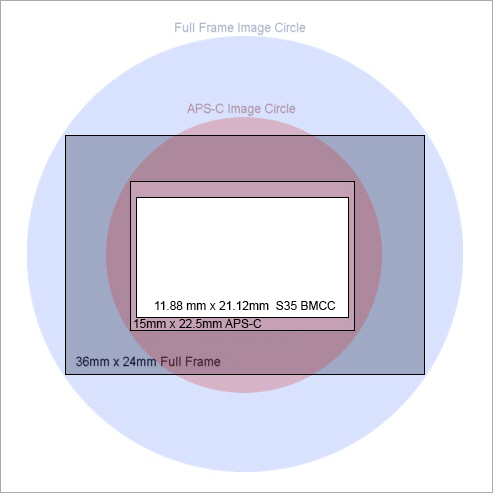But when I buy an APS-C lens, do I always get the crop?
Crop arises when we have a sensor that does not cover the full circumference of the REAR lens, see article on crop, whereas when a lens is born for APS-C it is made to properly cover the size of the aps-C sensor.
 As you can see in the image to the left, when making an aps-c lens the size of the back lens that focuses light rays on the sensor.
As you can see in the image to the left, when making an aps-c lens the size of the back lens that focuses light rays on the sensor.
The fact that in APS-C lenses the large front lens, larger than the sensor, does not mean that the back is not resized for proper focusing, otherwise there should be no point in making an APS-c lens, they would only make FullFrame lenses.
All the companies that make lenses, have lenses in their catalog that are optimized for FullFrame and lenses that are optimized for APS-C, so applying the concept of crop of fullframe lenses to aps-c lenses might be a wrong concept to begin with.
Again in this image you can also see the coverage of a cine sensor such as that of the BlackMagic Cinema Camera 4k, which is claimed to be an s35, slightly smaller in size than the aps-c, about half a millimeter in width and a millimeter and a half in height, this means that the lens is slightly abundant with respect to the sensor, just enough to avoid the risks of any vignetting with a wider angle lens, but at the same time no crop factors are risked that would force strange calculations or purchases on wide-angle lenses that are pushed.
This size factor allows me to safely say that on S35 machines like the BlackMagic Cinema Camera, quality lenses designed for APS-C are the optimal choice as a focal length-to-sensor ratio.
Why do I use the conditional verb? Because having done a bit of practical experimentation with multiple lenses, I have found that lens manufacturers really want to hurt their users … depending on the lenses, from the same manufacturer, there are aps-c lenses that insert the Crop or not, depending on how the lens groups within the lens are constructed and positioned..
So in a nutshell … you have to try and compare the lenses when you take them to see how and if they have a crop factor.
An example ? Canon’s excellent 17-55 2.8 is an APS-C lens designed for APS-C sensors but in reality it has only been optimized the rear lens for the APS-C format, it retains the crop as the position and management of internal lenses, so if you put this lens in 55mm we will have the same crop as if we had put a 55mm full frame lens…
For the proponents that focal length/angle is determined only by the internal lens spacing I remember that the different shape of the lenses determines the ability to collect light and convey rays from multiple directions, so the most pushed wide angle lenses are called fish eyes not only because of the angular reading ability but also because of the shape that resembles a fish eye dome, also if it was as they say it is only that, please explain to me the existence of focal multipliers, which allow you to double the focal length by not really lengthening the lens by the same distance from the sensor (200mm that becomes 400mm, but I don’t lengthen it by 20cm the tele), and focal reducers, which since the 1940s have existed either to be put in front of the lens (from anamorphic lenses to additional wide-angle lenses), or those like the speedboosters from metabone that pick up information that could not exist.
I reiterate the notion that there are lenses created for sensors to size and lenses cut for sensors to size, so the results are different and confirm both the crop and non-crop concepts, only that technically it is cheaper to cut a lens to size of a sensor or apply the crop directly than to introduce a focal reducer and then get the true focal length both as focal length (perspective distortion) and as focal angle (angular readability of the field of view).
